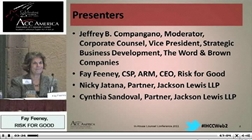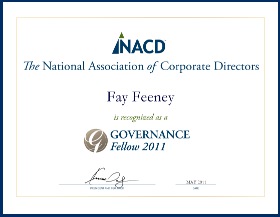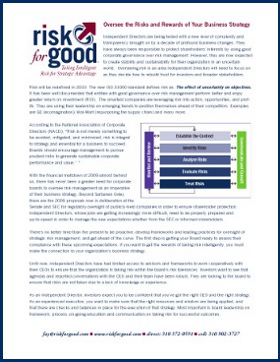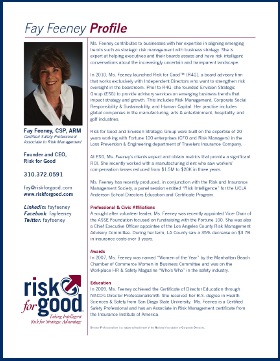Directorship 2020® is a NACD National initiative created to help directors identify and prepare for shifting issues and opportunities that boards will have to address in the future. Technology is and will continue to be an item that directors must understand in order to drive strategic change in their companies.
When it comes to technology, the boardroom has been learning a new language: mobile, social, cloud, cyber security, digital disruption and more. Recently the NACD released an eight-part video series on the board’s role: The Intersection of Technology, Strategy, and Risk.
We have spent much of the past year focused on cyber security, an essential discussion given the widespread theft of intellectual property, privacy invasions and data breaches. A report on cyber crime and espionage by the Center for Strategic and International Studies (CSIS) in Washington, D.C. last year estimated that cybercrime costs the global economy $300 billion a year – an entire industry is growing around hacking! Research by PwC shows cyber insurance is the fastest growing specialty coverage ever – worth around $1.3 billion a year in the US.
 As our boardroom agendas often get filled with discussions on risk, I asked Frontier Communications board director Larraine Segil how to shift the conversation to strategy. Larraine has a keen focus on opportunity and suggested we delve into solutions for governing “The Internet of Things (IoT)”. My favorite part of sitting on the NACD SoCal board with Larraine is her interest in what is emerging on the business horizon.
As our boardroom agendas often get filled with discussions on risk, I asked Frontier Communications board director Larraine Segil how to shift the conversation to strategy. Larraine has a keen focus on opportunity and suggested we delve into solutions for governing “The Internet of Things (IoT)”. My favorite part of sitting on the NACD SoCal board with Larraine is her interest in what is emerging on the business horizon.
As a director it is critical to be educated constantly about new trends, products and opportunities – competition is fast moving and customers are better educated about their options than ever before. Strategically the board has to think way ahead of the present status quo – and with the help of management and outside domain experts, explore opportunities for alliances.
This requires using strategic analysis at every board meeting (not just at one offsite a year) and welcoming constant director education and brainstorming both within and outside of the company’s industry. The board should continually identify and evaluate strategic directions to keep the company ‘fresh’ and nimble.
What exactly is the “Internet of Things” and what are the implications for business strategy? Think about connecting any device with an on and off switch to the Internet and/or to each other. This includes everything from cell phones, thermostats, and washing machines to headphones, cameras, wearable devices and much more.
This also applies to components of machines – for example, the jet engine of an airplane. If the device has an on and off switch then chances are it can be a part of the IoT.
The technology research firm Gartner says that by 2020 there will be over 26 billion connected devices. Think about Uber, the company that connects a physical asset (car & driver) to a person in need of a ride via a website. That simple connection has disrupted the taxi industry.
AirBnB has done the same for the lodging industry by directly connecting people with spaces to rent to those in need of accommodations. What does this mean to for our companies? Larraine, what are you thinking when you hear about the IoT for business opportunities?
As a director how can you help directors govern in this fast moving digital age?
Frontier Communications (Nasdaq: FTR) provides connectivity services to a national customer base primarily in rural areas and is integrally involved in the IoT. Frontier has a number of strategic alliances with companies that develop and market those very devices – or “things” – such as the Dropcam camera, a cloud-based WiFi video monitoring service with free live streaming, two-way talk, and remote viewing that makes it easy to stay connected with places, people and pets, no matter where you are. Other alliances expanding the “things” will be introduced in the rest of 2014.
As a director it is critical to be educated constantly about new trends, products and opportunities – competition is fast moving and customers are better educated about their options than ever before. Strategically the board has to think way ahead of the present status quo – and with the help of management and outside domain experts, explore opportunities for alliances.
This requires using strategic analysis at every board meeting (not just at one offsite a year) and welcoming constant director education and brainstorming both within and outside of the company’s industry. The board should continually identify and evaluate strategic directions to keep the company ‘fresh’ and nimble.
You can reach Larraine at www.lsegil.com
Remembering that we’ve only just begun, here are some critical questions boards should be asking about technology and the IoT.
1. Are you including strategic discussions around technology at every board meeting?
2. Do your strategic directions include alliances within and outside of your industry?
3. How would you assess your current level of interaction with the chief information officer (CIO) and chief technology officer (CTO)? What can be done to improve the effectiveness of communications both to and from him/her?
4. As a board, how are you helping to guide your company in innovative directions, taking into consideration disruptive technologies, competitor alliances, and new ideas or skills coming from outside your industry?
I look forward to seeing you at upcoming events and hearing from you on how we can keep our boardroom future focused. You can reach me at fay@riskforgood.com or on Twitter @fayfeeney












Speak Your Mind